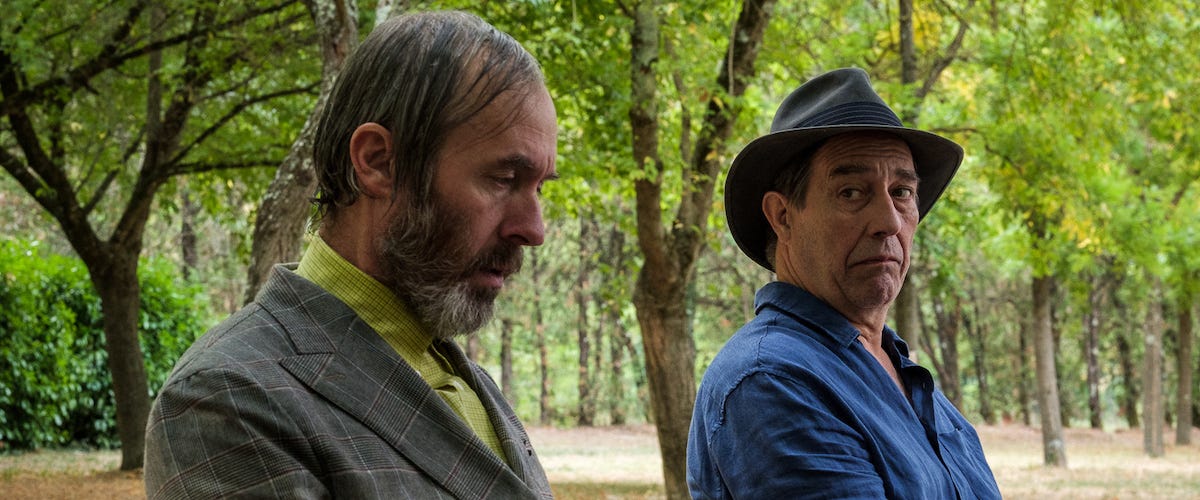This sleeper of a film won’t let you forget it, even if its thrills give you plenty to think about, yet you sleep comfortably afterwards. “The Man in the Hat” was released in 2020 to a cinema audience that wasn’t going to the cinema. Now it has roused from its slumber.
It’s from a little British independent filmmaker, Open Palm Films. The studio provides a summary: “The Man in the Hat journeys through France in a Fiat 500 accompanied by a framed photograph of an unknown woman. He is pursued by five angry men in a Citroën Dyane. Why are they chasing him? And how can he shake them off?”
Why, indeed? And how?
Directed and written by John-Paul Davidson and Stephen Warbeck, it’s a chase movie that will make you giggle from start to finish. The Fiat 500 isn’t one of those nippy ones we see everywhere these days. It’s an old, original one, one with a 500cc engine. It sputters a lot, when it starts at all. This is a slow-motion chase – in a slow-motion film.
The creaking Fiat is chased by an even less well-maintained Citroën Dyane. One review I saw says it’s a 2CV. That’s wrong. A 2CV is a far more elegant ugly-duckling of a car. Unlike the Dyane, it’s cherished across Europe, but with too little luggage space to carry what seems to be a dead body wrapped in black plastic, which the five evil-looking men riding in it tip into the river. The Dyane has an engine even smaller than the Fiat.
The hero, played by Ciarán Hinds – and he is a hero, of a strange sort – witnesses the event and makes a beeline out of town, with the five men in warm pursuit. Not hot. The cars don’t permit that, though the Fiat does boil over, and the weather’s hot enough already. And the get-away is indeed a beeline. Not a straight line. Not close. Bees meander when they fly, lighting on any flower they pass where the smell of nectar is strong.
Some of the reviews talk about it as if it were an advertisement for traveling in the south of France: gorgeous landscape, unglamorous people doing ordinary things with style, and I can see the point, sort of. A couple of guests in a tiny hotel burst into a pleasant song. One is a rather good tenor. The other plays guitar. But that’s just before another of the guests leaves the dinner table to kill himself.
It’s an example of what, back in 1960, the critic Martin Esslin called the “theatre of the absurd,” a label he attached to the works of Samuel Beckett, Eugène Ionesco and others, and what Wikipedia says occurs when “[l]ogical construction and argument give way to irrational and illogical speech and to the ultimate conclusion – silence.” Except this film is from 2020, and we’ve moved on, even if the Fiat 500 might have been new as Esslin was writing and now doesn’t move well at all.
For anyone trying to write a story of crime and its lack-of-punishment, pay close attention to the dialogue in this one. Listen to the closed mouth of the hero. Listen to his eyes. Listen to the eyebrows of the man under the bridge, the lady on the bicycle.
When it was first released, The Guardian’s reviewer called it “a Francophile fantasy that may be too twee for some, but the French tourist board will surely be satisfied.”
Which isn’t wrong but misses the philosophical point, as well as beauty in writing how the absurd ends in silence. Thankfully, having missed out in the cinemas, it has made its way into the streaming services. Don’t miss it now.
Esslin, M. (1960). The Theatre of the Absurd. The Tulane Drama Review, 4(4), 3-15. doi:https://doi.org/10.2307/1124873





We caught this last night on Amazon Prime. It is indeed a charming little film, and a bit mysterious, like a dream, and filled with the most interesting music--surely owing to the fact that its co-writer and co-director is the noted film composer, Stephen Warbeck [Shakespeare in Love, et al]. Great recommendation, Donald.
For US readers: it appears this film is currently available to view on Amazon Prime, free of extra charges for Prime Members. FYI.